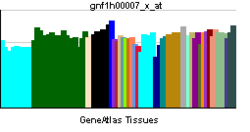Lymphotoxin alpha
Lymphotoxin-alpha (LT-alpha) or Tumor necrosis factor-beta (TNF-β) is a protein that in humans is encoded by the LTA gene.[1][2]
Function
Lymphotoxin alpha, a member of the tumor necrosis factor family, is a cytokine produced by lymphocytes. LTA is highly inducible, secreted, and exists as homotrimeric molecule. LTA forms heterotrimers with lymphotoxin-beta, which anchors lymphotoxin-alpha to the cell surface. LTA mediates a large variety of inflammatory, immunostimulatory, and antiviral responses. LTA is also involved in the formation of secondary lymphoid organs during development and plays a role in apoptosis.[3]
In LTα knockout mice, all Peyer's patches and lymph nodes will fail to develop indicating LTα's importance in immunological development.[4]
Interactions
Lymphotoxin alpha has been shown to interact with LTB.[5][6][7]
See also
References
- ↑ Nedwin GE, Naylor SL, Sakaguchi AY, Smith D, Jarrett-Nedwin J, Pennica D, Goeddel DV, Gray PW (Sep 1985). "Human lymphotoxin and tumor necrosis factor genes: structure, homology and chromosomal localization". Nucleic Acids Research 13 (17): 6361–73. doi:10.1093/nar/13.17.6361. PMC 321958. PMID 2995927.
- ↑ Aggarwal BB, Eessalu TE, Hass PE (February 1986). "Characterization of receptors for human tumour necrosis factor and their regulation by gamma-interferon". Nature 318 (6047): 665–7. doi:10.1038/318665a0. PMID 3001529.
- ↑ "Entrez Gene: LTA lymphotoxin alpha (TNF superfamily, member 1)".
- ↑ Akirav, Eitan; Liao, Shan; Ruddle, Nancy (2008). "Chapter 2: Lymphoid Tissues and Organs". In Paul, William. Fundamental Immunology (Book) (6th ed.). Philadelphia: Lippincott Williams & Wilkins. pp. 27–55. ISBN 0-7817-6519-6.
- ↑ Williams-Abbott L, Walter BN, Cheung TC, Goh CR, Porter AG, Ware CF (Aug 1997). "The lymphotoxin-alpha (LTalpha) subunit is essential for the assembly, but not for the receptor specificity, of the membrane-anchored LTalpha1beta2 heterotrimeric ligand". The Journal of Biological Chemistry 272 (31): 19451–6. doi:10.1074/jbc.272.31.19451. PMID 9235946.
- ↑ Browning JL, Sizing ID, Lawton P, Bourdon PR, Rennert PD, Majeau GR, Ambrose CM, Hession C, Miatkowski K, Griffiths DA, Ngam-ek A, Meier W, Benjamin CD, Hochman PS (Oct 1997). "Characterization of lymphotoxin-alpha beta complexes on the surface of mouse lymphocytes". Journal of Immunology 159 (7): 3288–98. PMID 9317127.
- ↑ Browning JL, Dougas I, Ngam-ek A, Bourdon PR, Ehrenfels BN, Miatkowski K, Zafari M, Yampaglia AM, Lawton P, Meier W (Jan 1995). "Characterization of surface lymphotoxin forms. Use of specific monoclonal antibodies and soluble receptors". Journal of Immunology 154 (1): 33–46. PMID 7995952.
Further reading
- Körner H, Sedgwick JD (Oct 1996). "Tumour necrosis factor and lymphotoxin: molecular aspects and role in tissue-specific autoimmunity". Immunology and Cell Biology 74 (5): 465–72. doi:10.1038/icb.1996.77. PMID 8912010.
- Wang Q (May 2005). "Molecular genetics of coronary artery disease". Current Opinion in Cardiology 20 (3): 182–8. doi:10.1097/01.hco.0000160373.77190.f1. PMC 1579824. PMID 15861005.
- Copeland KF (Dec 2005). "Modulation of HIV-1 transcription by cytokines and chemokines". Mini Reviews in Medicinal Chemistry 5 (12): 1093–101. doi:10.2174/138955705774933383. PMID 16375755.
- Elewaut D, Ware CF (Apr 2007). "The unconventional role of LT alpha beta in T cell differentiation". Trends in Immunology 28 (4): 169–75. doi:10.1016/j.it.2007.02.005. PMID 17336158.
| |||||||||
| ||||||||||||||||||||||||||||||||||||||||||||||||||||||||||||||||||||||||||||||||||



